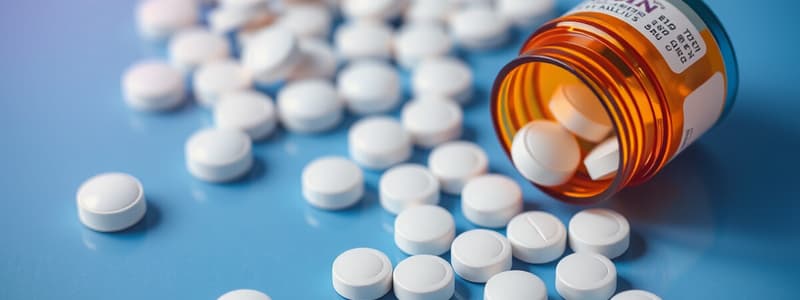Podcast
Questions and Answers
Usually food has what effect on drug dissolution and absorption?
Usually food has what effect on drug dissolution and absorption?
- Delays dissolution
- Interferes with absorption (correct)
- No effect
- Enhances absorption
What occurs during the vascular phase of inflammation?
What occurs during the vascular phase of inflammation?
Vasodilation with increased capillary permeability
What should concern the nurse about a client taking NSAIDs who complains of heartburn?
What should concern the nurse about a client taking NSAIDs who complains of heartburn?
Further investigation is needed
How does the NSAID work?
How does the NSAID work?
What is a common symptom of early toxicity related to aspirin?
What is a common symptom of early toxicity related to aspirin?
What is the half-life of aspirin in large doses?
What is the half-life of aspirin in large doses?
Which manifestations should concern the nurse regarding large doses of aspirin?
Which manifestations should concern the nurse regarding large doses of aspirin?
What should concern the RN about a 25-year-old client with asthma prescribed aspirin?
What should concern the RN about a 25-year-old client with asthma prescribed aspirin?
Which route of drug absorption has the greatest bioavailability?
Which route of drug absorption has the greatest bioavailability?
What is the best description of a drug's serum half-life?
What is the best description of a drug's serum half-life?
Which factors most commonly affect a drug's action? (Select all that apply)
Which factors most commonly affect a drug's action? (Select all that apply)
Excretion or elimination primarily occurs by which organ?
Excretion or elimination primarily occurs by which organ?
What is the best determinant of the biologic activity of a drug?
What is the best determinant of the biologic activity of a drug?
Which type of drug prevents or inhibits a cellular response?
Which type of drug prevents or inhibits a cellular response?
Which indicator measures the margin of safety of a drug?
Which indicator measures the margin of safety of a drug?
To avoid drug toxicity, how often should blood levels be drawn?
To avoid drug toxicity, how often should blood levels be drawn?
What information should the nurse provide to an individual taking NSAIDs? (Select all that apply)
What information should the nurse provide to an individual taking NSAIDs? (Select all that apply)
Which statement is true regarding anti-gout agents?
Which statement is true regarding anti-gout agents?
When discontinuing steroid therapy, how many days should the dosage be tapered over?
When discontinuing steroid therapy, how many days should the dosage be tapered over?
What information should be included when planning patient education regarding antigout drugs? (Select all that apply)
What information should be included when planning patient education regarding antigout drugs? (Select all that apply)
Which factor is most relevant to the relief of chronic pain?
Which factor is most relevant to the relief of chronic pain?
What is the opioid antagonist used to treat an overdose of morphine-like substances?
What is the opioid antagonist used to treat an overdose of morphine-like substances?
Withdrawal symptoms usually occur how many hours after the opioid dose?
Withdrawal symptoms usually occur how many hours after the opioid dose?
What should the RN assess to check if a client taking morphine for post-operative pain is having side effects?
What should the RN assess to check if a client taking morphine for post-operative pain is having side effects?
What should the client do if they experience dizzy spells while taking morphine?
What should the client do if they experience dizzy spells while taking morphine?
Flashcards
Food and Drug Absorption
Food and Drug Absorption
Food usually interferes with how well a drug dissolves and gets absorbed into the body.
Inflammation's Vascular Phase
Inflammation's Vascular Phase
This stage of inflammation involves blood vessels widening (vasodilation) and becoming more permeable, allowing fluids and cells to leak out.
NSAID Common Side Effect
NSAID Common Side Effect
A frequent side effect of NSAIDs is heartburn. If someone reports heartburn, it should be looked into further.
How NSAIDs Work
How NSAIDs Work
Signup and view all the flashcards
Early Sign of Aspirin Toxicity?
Early Sign of Aspirin Toxicity?
Signup and view all the flashcards
Aspirin Half-Life
Aspirin Half-Life
Signup and view all the flashcards
Aspirin and Gastrointestinal Distress
Aspirin and Gastrointestinal Distress
Signup and view all the flashcards
Aspirin and Asthma
Aspirin and Asthma
Signup and view all the flashcards
Highest Bioavailability
Highest Bioavailability
Signup and view all the flashcards
Drug Half-Life
Drug Half-Life
Signup and view all the flashcards
Factors Affecting Drug Action
Factors Affecting Drug Action
Signup and view all the flashcards
Main Way Drugs Leave the Body
Main Way Drugs Leave the Body
Signup and view all the flashcards
Key to Drug Activity
Key to Drug Activity
Signup and view all the flashcards
Drugs that Block Action
Drugs that Block Action
Signup and view all the flashcards
Therapeutic Index
Therapeutic Index
Signup and view all the flashcards
Monitoring Drug Toxicity
Monitoring Drug Toxicity
Signup and view all the flashcards
NSAID Patient Education: Stomach Issues
NSAID Patient Education: Stomach Issues
Signup and view all the flashcards
NSAID Patient Education: Stool and Bruising
NSAID Patient Education: Stool and Bruising
Signup and view all the flashcards
NSAID Patient Education: Menstrual Flow
NSAID Patient Education: Menstrual Flow
Signup and view all the flashcards
Anti-Gout Agent
Anti-Gout Agent
Signup and view all the flashcards
Steroid Therapy Withdrawal
Steroid Therapy Withdrawal
Signup and view all the flashcards
Steroid Therapy Withdrawal: Hydration
Steroid Therapy Withdrawal: Hydration
Signup and view all the flashcards
Antigout Drug Education
Antigout Drug Education
Signup and view all the flashcards
Long-Acting Drugs for Chronic Pain
Long-Acting Drugs for Chronic Pain
Signup and view all the flashcards
Opioid Overdose Treatment
Opioid Overdose Treatment
Signup and view all the flashcards
Opioid Withdrawal Timeline
Opioid Withdrawal Timeline
Signup and view all the flashcards
Monitoring Morphine Side Effects: Urinary Retention
Monitoring Morphine Side Effects: Urinary Retention
Signup and view all the flashcards
Morphine Side Effects: Safety
Morphine Side Effects: Safety
Signup and view all the flashcards
Study Notes
Drug Effects on Absorption
- Food generally interferes with drug dissolution and absorption.
Inflammation Response
- Vascular phase of inflammation includes vasodilation and increased capillary permeability.
NSAID Side Effects
- Common side effect of NSAIDs includes heartburn; further investigation may be necessary if reported by clients.
Mechanism of NSAIDs
- NSAIDs inhibit synthesis of prostaglandins, which reduces pain and inflammation.
Aspirin Use Considerations
- Tinnitus is an early symptom of aspirin toxicity.
- Aspirin has a half-life of approximately 15-30 hours when taken in large doses.
- Aspirin not taken at mealtime may cause gastrointestinal distress.
Aspirin and Asthma
- In asthmatic patients, aspirin can trigger bronchospasms and should be used with caution.
Drug Absorption Bioavailability
- Intravenous (IV) route has the greatest bioavailability among drug absorption methods.
Drug Half-Life Definition
- A drug’s serum half-life is defined as the time required for half of the drug to be eliminated after absorption.
Factors Affecting Drug Action
- Common factors affecting drug action include poor circulation, pain, stress, hunger, and fasting.
Drug Excretion
- The kidneys are primarily responsible for the excretion or elimination of drugs from the body.
Drug Activity Determinant
- The fit of the drug at the receptor site is the best determinant of its biological activity.
Drug Response Inhibition
- Antagonists are drugs that prevent or inhibit a cellular response.
Therapeutic Index
- The therapeutic index measures the margin of safety of a drug.
Monitoring Drug Toxicity
- Blood levels should be drawn at periodic intervals to avoid drug toxicity.
NSAID Patient Education
- Clients should report epigastric distress.
- Observation for tarry stools and bruising is critical during extended NSAID use.
- Clients should avoid NSAIDs during heavy menstrual flow.
Anti-Gout Agent Facts
- Colchicine is used for managing acute gout attacks.
Steroid Therapy Withdrawal
- When discontinuing steroids, the dosage should be tapered over 5 to 10 days.
- Increased fluid intake is advised during tapering.
Antigout Drug Education
- Patients should avoid alcohol, caffeine, and high-purine foods.
- Medications should be taken with food.
Chronic Pain Management
- Use of drugs with long half-lives is relevant to effectively relieve chronic pain.
Opioid Antagonist
- Naloxone is the opioid antagonist used to treat morphine-like overdoses.
Opioid Withdrawal Symptoms
- Withdrawal symptoms typically occur 8 to 24 hours after an opioid dose.
Monitoring Morphine Side Effects
- Assess for urinary retention in clients taking morphine for post-operative pain.
Morphine Side Effects and Safety
- Clients taking morphine should be advised to move slowly to avoid dizziness and falls.
Studying That Suits You
Use AI to generate personalized quizzes and flashcards to suit your learning preferences.




